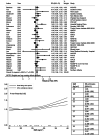Postdiagnosis body fatness, weight change and breast cancer prognosis: Global Cancer Update Program (CUP global) systematic literature review and meta-analysis
- PMID: 36279884
- PMCID: PMC10092239
- DOI: 10.1002/ijc.34322
Postdiagnosis body fatness, weight change and breast cancer prognosis: Global Cancer Update Program (CUP global) systematic literature review and meta-analysis
Abstract
Previous evidence on postdiagnosis body fatness and mortality after breast cancer was graded as limited-suggestive. To evaluate the evidence on body mass index (BMI), waist circumference, waist-hip-ratio and weight change in relation to breast cancer prognosis, an updated systematic review was conducted. PubMed and Embase were searched for relevant studies published up to 31 October, 2021. Random-effects meta-analyses were conducted to estimate summary relative risks (RRs). The evidence was judged by an independent Expert Panel using pre-defined grading criteria. One randomized controlled trial and 225 observational studies were reviewed (220 publications). There was strong evidence (likelihood of causality: probable) that higher postdiagnosis BMI was associated with increased all-cause mortality (64 studies, 32 507 deaths), breast cancer-specific mortality (39 studies, 14 106 deaths) and second primary breast cancer (11 studies, 5248 events). The respective summary RRs and 95% confidence intervals per 5 kg/m2 BMI were 1.07 (1.05-1.10), 1.10 (1.06-1.14) and 1.14 (1.04-1.26), with high between-study heterogeneity (I2 = 56%, 60%, 66%), but generally consistent positive associations. Positive associations were also observed for waist circumference, waist-hip-ratio and all-cause and breast cancer-specific mortality. There was limited-suggestive evidence that postdiagnosis BMI was associated with higher risk of recurrence, nonbreast cancer deaths and cardiovascular deaths. The evidence for postdiagnosis (unexplained) weight or BMI change and all outcomes was graded as limited-no conclusion. The RCT showed potential beneficial effect of intentional weight loss on disease-free-survival, but more intervention trials and well-designed observational studies in diverse populations are needed to elucidate the impact of body composition and their changes on breast cancer outcomes.
Keywords: Body fatness; breast cancer survival; evidence grading; systematic review; weight change.
© 2022 The Authors. International Journal of Cancer published by John Wiley & Sons Ltd on behalf of UICC.
Conflict of interest statement
The authors declare no conflict of interest.
Figures



References
-
- Ferlay JEM, Lam F, Colombet M, et al. Global Cancer Observatory: Cancer Today. Lyon, France: International Agency for Research on Cancer; 2020.
-
- Chan DSM, Abar L, Cariolou M, et al. World Cancer Research Fund international: continuous update project‐systematic literature review and meta‐analysis of observational cohort studies on physical activity, sedentary behavior, adiposity, and weight change and breast cancer risk. Cancer Causes Control. 2019;30:1183‐1200. - PubMed
-
- World Cancer Research Fund/American Institute for Cancer Research , 2018. Diet, nutrition, physical activity and cancer: a global perspective. Continuous Update Project Expert Report.
Publication types
MeSH terms
Grants and funding
LinkOut - more resources
Full Text Sources
Medical

